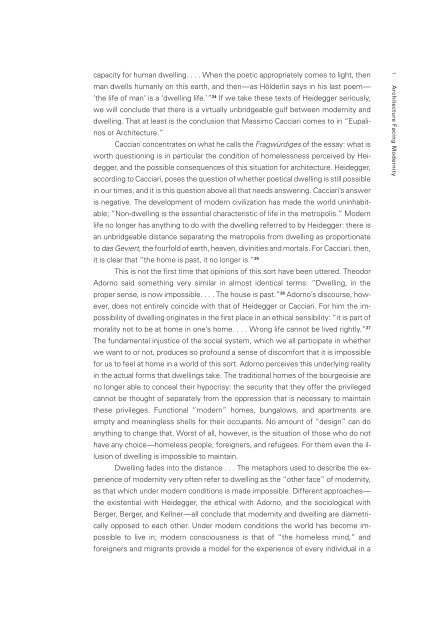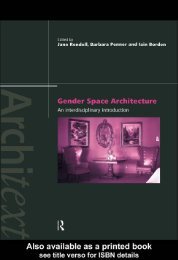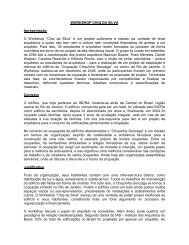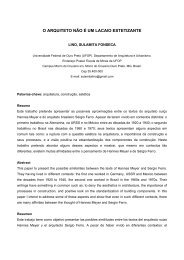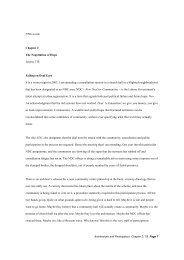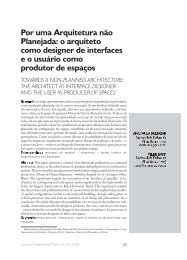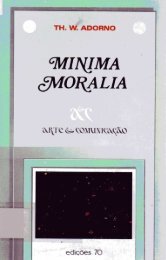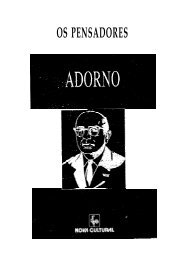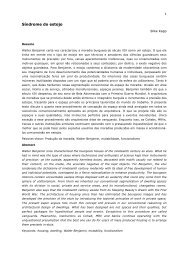Architecture and Modernity : A Critique
Architecture and Modernity : A Critique
Architecture and Modernity : A Critique
Create successful ePaper yourself
Turn your PDF publications into a flip-book with our unique Google optimized e-Paper software.
capacity for human dwelling. . . . When the poetic appropriately comes to light, then<br />
man dwells humanly on this earth, <strong>and</strong> then—as Hölderlin says in his last poem—<br />
’the life of man’ is a ‘dwelling life.’” 24 If we take these texts of Heidegger seriously,<br />
we will conclude that there is a virtually unbridgeable gulf between modernity <strong>and</strong><br />
dwelling. That at least is the conclusion that Massimo Cacciari comes to in “Eupalinos<br />
or <strong>Architecture</strong>.”<br />
Cacciari concentrates on what he calls the Fragwürdiges of the essay: what is<br />
worth questioning is in particular the condition of homelessness perceived by Heidegger,<br />
<strong>and</strong> the possible consequences of this situation for architecture. Heidegger,<br />
according to Cacciari, poses the question of whether poetical dwelling is still possible<br />
in our times, <strong>and</strong> it is this question above all that needs answering. Cacciari’s answer<br />
is negative. The development of modern civilization has made the world uninhabitable;<br />
“Non-dwelling is the essential characteristic of life in the metropolis.” Modern<br />
life no longer has anything to do with the dwelling referred to by Heidegger: there is<br />
an unbridgeable distance separating the metropolis from dwelling as proportionate<br />
to das Geviert, the fourfold of earth, heaven, divinities <strong>and</strong> mortals. For Cacciari, then,<br />
it is clear that “the home is past, it no longer is.” 25<br />
This is not the first time that opinions of this sort have been uttered. Theodor<br />
Adorno said something very similar in almost identical terms: “Dwelling, in the<br />
proper sense, is now impossible. . . . The house is past.” 26 Adorno’s discourse, however,<br />
does not entirely coincide with that of Heidegger or Cacciari. For him the impossibility<br />
of dwelling originates in the first place in an ethical sensibility: “it is part of<br />
morality not to be at home in one’s home. . . . Wrong life cannot be lived rightly.” 27<br />
The fundamental injustice of the social system, which we all participate in whether<br />
we want to or not, produces so profound a sense of discomfort that it is impossible<br />
for us to feel at home in a world of this sort. Adorno perceives this underlying reality<br />
in the actual forms that dwellings take. The traditional homes of the bourgeoisie are<br />
no longer able to conceal their hypocrisy: the security that they offer the privileged<br />
cannot be thought of separately from the oppression that is necessary to maintain<br />
these privileges. Functional “modern” homes, bungalows, <strong>and</strong> apartments are<br />
empty <strong>and</strong> meaningless shells for their occupants. No amount of “design” can do<br />
anything to change that. Worst of all, however, is the situation of those who do not<br />
have any choice—homeless people, foreigners, <strong>and</strong> refugees. For them even the illusion<br />
of dwelling is impossible to maintain.<br />
Dwelling fades into the distance . . . The metaphors used to describe the experience<br />
of modernity very often refer to dwelling as the “other face” of modernity,<br />
as that which under modern conditions is made impossible. Different approaches—<br />
the existential with Heidegger, the ethical with Adorno, <strong>and</strong> the sociological with<br />
Berger, Berger, <strong>and</strong> Kellner—all conclude that modernity <strong>and</strong> dwelling are diametrically<br />
opposed to each other. Under modern conditions the world has become impossible<br />
to live in; modern consciousness is that of “the homeless mind,” <strong>and</strong><br />
foreigners <strong>and</strong> migrants provide a model for the experience of every individual in a<br />
1 <strong>Architecture</strong> Facing <strong>Modernity</strong>


